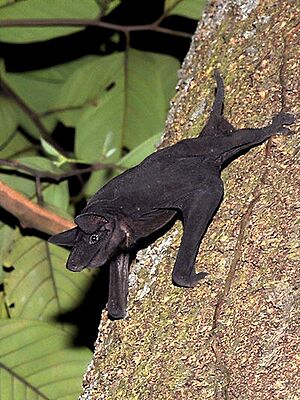Hairless bat facts for kids
Quick facts for kids Hairless bat |
|
|---|---|
 |
|
| Conservation status | |
| Scientific classification | |
| Genus: |
Cheiromeles
|
| Species: |
torquatus
|
 |
|
The hairless bat (Cheiromeles torquatus), also known as the naked bulldog bat, is a special type of bat. It belongs to the Molossidae family. Its scientific name, Cheiromeles, comes from a Greek word meaning "hand." The second part, torquatus, is Latin for "collar."
These bats are excellent hunters. They use a skill called echolocation. This is like a natural sonar system. It helps them find insects flying in the air.
Even though they are called "hairless," these bats do have some short, stiff hairs. You can find these hairs around their neck and on their front toes. They also have fine hairs on their head and tail membrane.
Contents
Where Hairless Bats Live
Hairless bats mostly live in Southeast Asia. You can find them in countries like Myanmar, Indonesia, Malaysia, Thailand, and the Philippines. They also live on islands such as Java, Sumatra, and Borneo.
It's hard to count how many hairless bats there are. They are spread out and not often seen. They like to live in lowlands, marshes, and rocky areas. You might find them in holes, dens, or trees. These bats often live in groups. They roost together to save energy. They are usually harmless. However, they can be a problem in some rice farms.
What Hairless Bats Look Like
Hairless bats have dark grey skin. Most of their skin is hairless. But they might have small patches of fine hair around their throat. They also have some hair under their back feet.
These bats have special glands on their neck. They use these glands to mark their territory with a scent. Sometimes, they have pouches near their ears or under their neck. These pouches might be used for carrying or protecting their young.
A hairless bat has a wide face and a strong jaw. Its wings are wide, and its tail sticks out. The tail is longer than its back legs. The first toe on their foot has a nail instead of a claw. This toe can also grip things.
Hairless Bat Reproduction
Hairless bats usually have two groups of babies each year. When the babies are born, the mother leaves them at the roost. She then goes out to hunt for food. Male bats typically do not help care for the young.
Hairless Bat Behavior
These bats are nocturnal. This means they are active at night. They also migrate, which means they move from one place to another. They live in colonies, or large groups.
Hairless bats start hunting early in the morning. They usually hunt for larger insects than other types of bats.
Threats to Hairless Bats
The number of hairless bats is going down. One big reason is that their roosting spots are being destroyed. When their homes are broken up, they have to move. This can make them isolated from other bats.
Some local people in Malaysia hunt these bats for food. This is also greatly reducing their population. Because of these threats, hairless bats are becoming vulnerable.
Helping Hairless Bats
Hairless bats help control pests. But their population is in danger because of human activities. People are trying to help them recover in some areas. Some bats are being moved to protected places. Their habitats are also being rebuilt. Efforts are also being made to teach local people how important these bats are for the environment.


